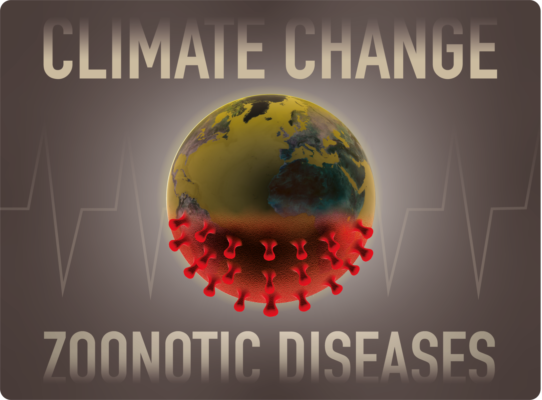COVID-19 is a zoonotic disease. So is Monkeypox. What do I mean by zoonotic? These are diseases that transfer from non-humans to us. Zoonotic is the category. Each disease is called a zoonosis.
The World Health Organization (WHO) defines zoonosis as an infection that jumps to humans from vertebrate animals. In other words, not from a mosquito or tick. Zoonoses (the plural for zoonosis) are increasingly becoming a primary human disease source. The WHO calls them a growing public health problem because of our increasing encroachment into natural environments.
And when a zoonosis transfers to humans, in entering a new environment it begins to mutate to become a pandemic or endemic. Such has been the case with COVID-19, Ebola, SARS, and now monkeypox.
But it isn’t just our encroachment into nature that is fueling the spread of zoonotic diseases. Climate change is acting as an accelerant. How so?
An Inside Climate News article written by Victoria St. Martin and published on June 7th quotes a research study which states that zoonotic disease spread is something “we can’t put…back in the bottle.”
The study published in the journal Nature was headed up by Georgetown University’s Colin Carlson, an assistant professor of biology. Carlson states, “We know that species are on the move….we know that probably has relevance to other viruses….what does that mean for human health? What does it mean for pandemics?”
So why are species on the move? Because climate change is altering the conditions for their survival. Drought, extreme heat, floods, wildfires, and more environmental disruptions associated with climate change is leading the way. Even in the oceans of the world as they continue to warm, temperate fish species are moving poleward as tropical and subtropical species move away from equatorial regions. On land, the same is happening.
The Nature study notes there are at least 10,000 virus species in vertebrate animals with the capacity to infect humans. The vast majority continue to circulate in their hosts. But Carlson’s predictions based on migration from, and increasing human encroachment to tropical rainforests, in particular, will lead to, within the next 50 years, as many as 4,000 of these leaping to humans.
Carlson’s research team looked at viral sharing in the wild and how geographic range shifts from climate change will put more than 3,100 mammal species in much closer contact with human populations. The hotspots are where we are most abundant, in Africa and Asia. The research shows that the vast majority of these zoonotic diseases will come from bats comingling with humans. And as we already know that’s the story behind the emergence of COVID-19 and the global pandemic that is now into its third year.
If all of this seems new to you, let me mention rabies. Rabies was probably the most recognizable zoonotic disease before COVID-19 arrived on the scene. Caused by the Lyssavirus, it leaped from dogs to humans through the former’s saliva. It could only be transmitted when a rabid dog bit a human, not from being licked. Today rabies is endemic to every continent except Antarctica and causes tens of thousands of deaths annually with 95% of the cases in Asia and Africa. Although it is preventable through canine vaccinations, the disease remains endemic to this day.
The latest zoonotic viral disease to make headlines is monkeypox. Caused by an Orthopoxvirus that is known as the cause of smallpox and cowpox, it was first identified in laboratory monkeys in 1958. In 1970, the first human case was reported in The Democratic Republic of the Congo. Later cases appeared in several West and Central African countries.
The natural reservoir for monkeypox, states the US Centers for Disease Control and Prevention, remains unknown. The suspects include African rodents and several monkey species.
Unlike COVID-19, monkeypox is not an airborne spreader. It requires direct contact with an infection source. Open sores, bites, and intimate contact between humans, as well as the handling of infected wild animals, have likely facilitated the current outbreak across the globe. And although monkeypox will mutate, current research doesn’t indicate it will alter its form of transmission.
Are all zoonotic diseases spread directly from vertebrate animals to humans? No. Many require an insect intercessor. Lyme Disease was originally thought to be caused by a bacteria, Borrelia, found in wild deer populations. But were the deer the original host? Or were they infected by a tick that is known today to be the source of human infections? Several bird species carry Borrelia infections. But it is more likely that these birds, the deer, and we humans have all gotten it from an invertebrate source.
Where does climate change come into the picture for Lyme Disease? The range of the ticks is spreading as winters become less extreme in mid-latitude zones across North America and Europe. The carriers are black-legged ticks that now can overwinter in places where in the past the cold would have killed them. Originally called deer ticks, a misnomer, these invertebrates are increasing their range in North America and Europe causing an uptick (forgive the pun) in Lyme’s spread.









